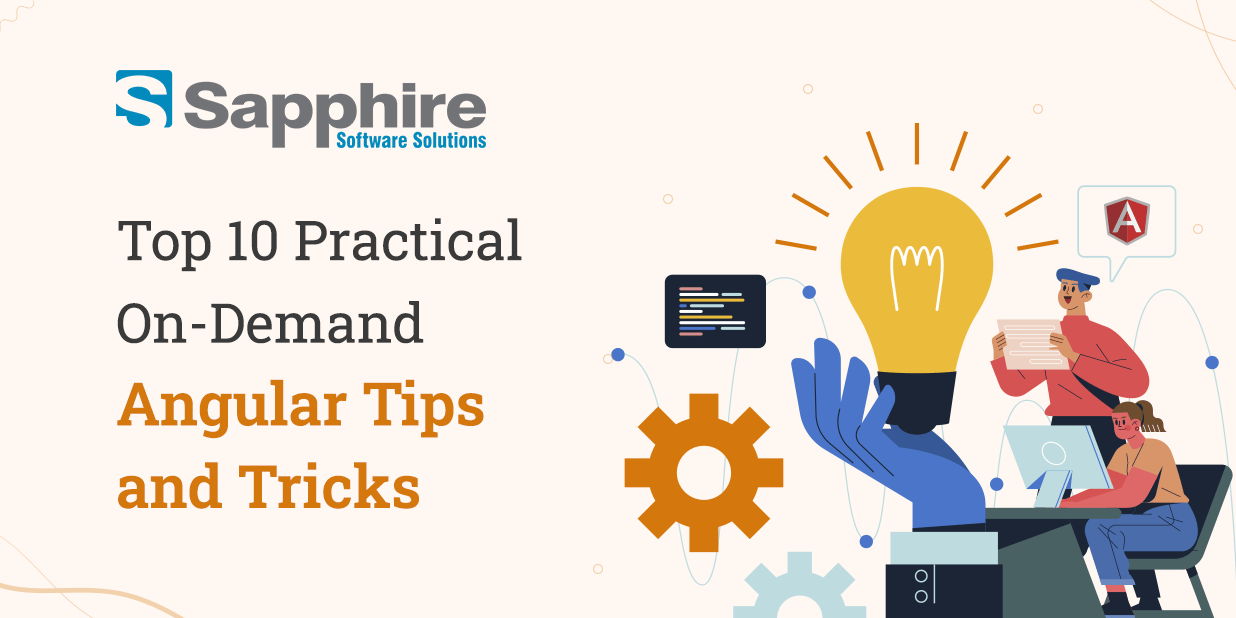A solid and well-liked JavaScript framework, Angular, created and maintained by Google, enables programmers to create dynamic and feature-rich online apps. Although Angular offers a solid basis for web development, some doable tips and tactics may significantly improve the process. This extensive essay delves into 10 on-demand Angular tips and practices that should improve your ability to create applications.
Single-page applications (SPAs) are naturally supported by the design of Angular, providing a fluid and responsive user experience. However, understanding and putting into practice specific tactics may make all the difference in fully realizing the promise of the framework. These pointers cover various application development topics, from speed optimization to efficient state management and intelligent component interaction to error handling.
Users want quicker load times, more fluid interactions, and more security as the digital world develops. You may meet and surpass these objectives by using these well-chosen Angular workflow hacks. This post gives valuable tips to improve your Angular development journey, whether you’re a beginner trying to shorten your learning curve or an experienced developer looking to polish your skills. Hire Angular Developer in USA from Sapphire Software Solutions for your upcoming projects.
Best Practical On-Demand Angular Tips and Tricks:-
Join us as we explore Angular’s potential and get the skills necessary to create innovative and excellent apps.
1. Lazy Loading Modules for Performance:
Angular’s lazy loading strategy includes loading modules as needed rather than all at once when the application first loads. This method dramatically boosts speed by reducing the first load time and initial bundle size. When the relevant route is hit, your application will only retrieve the necessary modules when you divide it into smaller feature modules and use lazy loading. By only loading resources when they are required, this not only reduces the time it takes for an application to load but also optimizes memory utilization. Configure your routes to load the module using the loadChildren property, referring to the module’s path, to perform lazy loading. Users will benefit from quicker loading times and a more responsive application.
2. Effective Use of NgModules:
NgModules, a fundamental idea in Angular, assists in structuring your application into valuable modules. To ensure maintainable code and to minimize performance problems, it’s crucial to utilize them properly. Remember the adage “one module, one responsibility.” Avoid building too complicated or too big modules, and group relevant components, services, and directives together in a module. Module dependencies should be carefully planned to ensure that modules only import what they need. Angular development services providers can use feature modules to encapsulate certain functionality and ensure that modules aren’t connected. Following these best practices, you can build a modular, maintainable, and efficient Angular application.
3. Optimize Change Detection:
The user interface is updated when data in the application changes, thanks to Angular’s change detection technique. However, the efficacy of change detection may be impacted by its indiscriminate usage. Consider utilizing the OnPush change detection method to improve it. With this approach, Angular only checks for changes when the component’s inputs have changed. Performance may be improved, and needless reevaluations can be significantly decreased. Immutability and OnPush together may provide predictable data flows. To prevent too many automated checks, manually utilize the ChangeDetectorRef class to initiate change detection as necessary. You can make Angular apps more effective and responsive by improving change detection.
4. Clever Component Interaction with Input and Output:
An essential part of Angular programming is component interaction. The @Input and @Output decorators help components communicate with one another. Your components will be reusable and maintainable if designed with distinct input and output bounds. When data is sent from a parent component to a child component through an input property, alterations to the data cause the child component’s view to update automatically. Similarly, @Output enables parent components to react to activities or changes inside the child by emitting events from the child component. Component communication that is appropriately designed enhances component independence while reducing tight coupling, creating a more modular and adaptable application architecture.
5. Harness the Power of RxJS:
The asynchronous actions of Angular depend on the reactive programming library RxJS. You can handle complicated asynchronous circumstances more gracefully if you grasp RxJS. It is essential to comprehend observables, operators, and topics. You can easily handle asynchronous data flows by representing data streams across time as observables. You can effectively alter, filter, and combine these streams using operators. Multicasting values to several observers is made possible by subjects. Code may be made simpler, complicated asynchronous tasks can be handled, and Angular apps can be more responsive and engaging by successfully using RxJS.
6. Efficient Forms Handling:
Web applications must handle forms, and Angular offers two main methods: reactive and template-driven forms. Reactive forms are created programmatically using form control objects instead of template-driven forms, which depend on directives to generate the forms in the template. Depending on the complexity of your application, choose the suitable strategy. To guarantee data integrity, implement appropriate validation using built-in or custom validators. Effectively handle form submissions and user interactions and control form state by monitoring modifications and validation results. Using the proper form handling methodology and methods, you may design user-friendly, validated, and effective forms in your Angular application.
7. Performance Optimization with Angular CLI:
To improve the speed of your application, Angular CLI offers several optimization options. Faster loading and better performance result from Ahead-of-Time (AOT) compilation, which transforms your TypeScript and HTML into optimized JavaScript code during build time. Tree-shaking reduces the size and improves the performance of your application bundles by removing superfluous code. By deleting extraneous characters from the code, minification decreases the bundle size. If these optimization approaches use Angular CLI commands, your application will be leaner, load quicker, and provide a better user experience.
8. Route Guards for Enhanced Security:
Route guards are crucial for safeguarding the routes in your application and managing navigation. In addition to the canActivate, canActivateChild, can deactivate, and resolve guards, Angular also provides other sorts of route guards. Can-activated guards use authentication and permission requirements. Using canActivateChild, a parent route’s child routes can be protected. You may use deactivate guards to stop navigation away from a route when certain circumstances, such as unsaved modifications, exist. Resolve guards assist in data retrieval before route activation. You may strengthen the security of your application by carefully deploying these guards, ensuring users can only access approved routes and resources.
9. State Management with NgRx:
Effective state management becomes essential for more extensive and more complicated systems. NgRx is an Angular state management framework that uses the Redux design paradigm. It offers a centralized, predictable method for managing the application state. Actions, reducers, effects, and selectors are the fundamental components of NgRx. Effects control side effects like asynchronous operations, actions that represent events that cause state changes, reducers handle these actions and update the state, and selectors provide users access to specific state components. By implementing NgRx, you can centralize the state management of your application, improving maintainability, debugging, and data handling across components.
10. Effective Error Handling and Logging:
To identify problems in production situations, comprehensive error handling and logging techniques are crucial. To detect and manage unexpected failures, Angular offers a mechanism to establish global error handlers. You may gracefully manage runtime problems by implementing a global error handler, which will help you avoid application crashes and enhance user experience. You may also acquire essential details about the operation of the application and any issues that occur by integrating logging services like console.log console. Error or third-party logging solutions. Effective logging helps you diagnose problems, identify performance bottlenecks, and make wise choices about improving your Angular application.
Conclusion:
An Angular development company can create high-quality apps with improved speed, security, and maintainability by learning these 10 helpful Angular tips and techniques. Developers can make sure their Angular applications adhere to contemporary development standards and provide exceptional user experiences by utilizing lazy loading, optimizing change detection, effectively handling component interaction, leveraging RxJS, implementing efficient forms, utilizing Angular CLI optimizations, utilizing route guards, adopting NgRx for state management, and implementing effective error handling and logging. Being an expert, Angular developer requires constantly exploring Angular’s capabilities and keeping current with best practices.





































